Her Majesty Queen Elizabeth II, Britain’s longest reigning monarch, has died at home in Balmoral in Scotland, aged 96, surrounded by her children including her eldest son, now King Charles III.
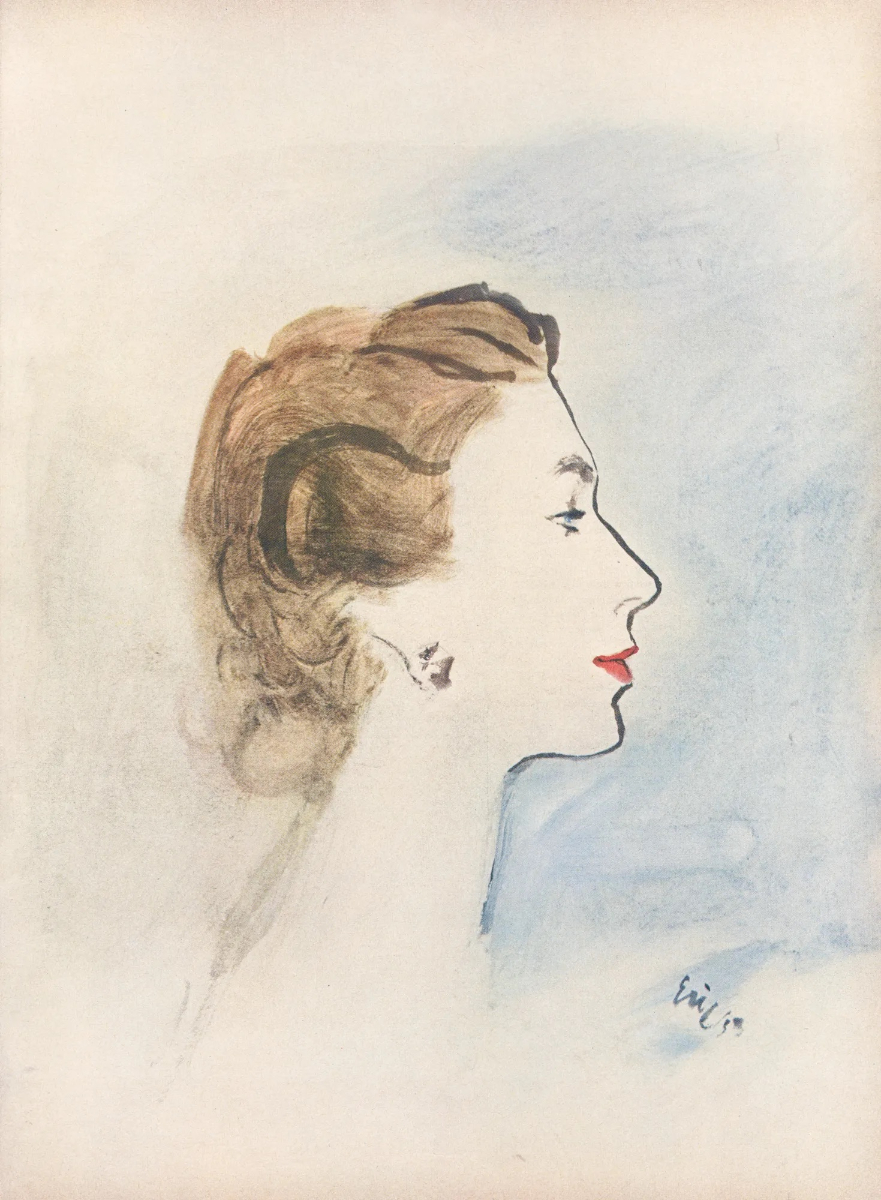
Illustration by Carl Oscar August Erickson, Vogue, 1957.
Illustration by Carl Oscar August Erickson, Vogue, 1957.
Her Majesty Queen Elizabeth II, Britain’s longest reigning monarch, has died at home in Balmoral in Scotland, aged 96, surrounded by her children including her eldest son, now King Charles III.
Through the 70 years of her reign, years of devoted service to her country and the Commonwealth and its peoples, the Queen has been globally revered and widely beloved as she weathered a roiling century and some personal storms with enduring equanimity and grace. She witnessed history being made and was a part of it. Her knowledge of world events, politics, and power structures was nonpareil. Known to us all as a symbol of stability, she was at once a figure so potent that she visited her subjects in our dreams and was perceived as an extended part of our families, but nevertheless guarded her inner world with the strength of the monarchs who built Britain, remaining in many ways inscrutable to the end.
Princess Elizabeth Alexandra Mary (carefully named for one distinguished British monarch, her devoted grandmother, and her great-grandmother Queen Alexandra), made her formal debut in Vogue in the August 15th issue, 1927, flashing a beaming smile for the society photographer Marcus Adams and even coaxing one from her grandmother, George V’s consort, Queen Mary, who firmly counseled that smiling in public was unregal, and upon whose knee she sat.
The princess had been born to a famously happy home. The young princess’s father, born Prince Albert, was the excruciatingly shy, stuttering second son of the martinet King George V and the frigidly correct Queen Mary. His glamorous older brother Prince David, the Duke of Windsor, was destined to be king, and not too many eyebrows were raised therefore when Albert fell madly in love with, as Vogue put it, a woman who would become “our first consort in centuries not a royalty born.” Lady Elizabeth Bowes Lyon, daughter of the Earl of Strathmore and Kinghorne, was raised at storied Glamis Castle, a place of doughty stone walls and spiky grey turrets built at the turn of the 15th century.
The princess had been born to a famously happy home. The young princess’s father, born Prince Albert, was the excruciatingly shy, stuttering second son of the martinet King George V and the frigidly correct Queen Mary. His glamorous older brother Prince David, the Duke of Windsor, was destined to be king, and not too many eyebrows were raised therefore when Albert fell madly in love with, as Vogue put it, a woman who would become “our first consort in centuries not a royalty born.” Lady Elizabeth Bowes Lyon, daughter of the Earl of Strathmore and Kinghorne, was raised at storied Glamis Castle, a place of doughty stone walls and spiky grey turrets built at the turn of the 15th century.
As Vogue noted approvingly, she was “the youngest but one of a family of ten, and she has had the best social training known to man—to be part of an enormous family enjoying a perpetual house party. When five, she met the future King: he remembers this, for he was ten. The elder sisters all made good, but unsensational matches.”
The First World War transformed Glamis into a war hospital (and killed Lady Elizabeth’s beloved brother Fergus). When a fire broke out at the castle it was Lady Elizabeth who rang the fire brigades and with some presence of mind organized relays to bring the treasures out of the castle to safety. “When she came out,” noted Vogue, of her 1919 debut in society, “some thought her the best dancer among the debutantes, and she acted as a hostess at home, when her mother was ill, to a party that included her future husband—whom she had already met through her friend, Princess Mary,” the Princess Royal, his sister. “Bertie,” as he was known to friends and family, was smitten, although a generation earlier he would have been expected to marry a fellow royal. Queen Mary went to pay a visit to see what all the fuss was about. But Lady Elizabeth was quite a catch and stammering Bertie, prince of the land, had to propose three times before he received the answer he desired. (He was initially turned down because, in Lady Elizabeth’s words, she was “afraid never, never again to be free to think, speak and act as I feel I really ought to.”) When she finally accepted the prince’s hand Sir Henry Chatham noted in his diary that “There is not a man in the whole of England who does not envy him.”)
As Vogue noted approvingly, she was “the youngest but one of a family of ten, and she has had the best social training known to man—to be part of an enormous family enjoying a perpetual house party. When five, she met the future King: he remembers this, for he was ten. The elder sisters all made good, but unsensational matches.”
The First World War transformed Glamis into a war hospital (and killed Lady Elizabeth’s beloved brother Fergus). When a fire broke out at the castle it was Lady Elizabeth who rang the fire brigades and with some presence of mind organized relays to bring the treasures out of the castle to safety. “When she came out,” noted Vogue, of her 1919 debut in society, “some thought her the best dancer among the debutantes, and she acted as a hostess at home, when her mother was ill, to a party that included her future husband—whom she had already met through her friend, Princess Mary,” the Princess Royal, his sister. “Bertie,” as he was known to friends and family, was smitten, although a generation earlier he would have been expected to marry a fellow royal. Queen Mary went to pay a visit to see what all the fuss was about. But Lady Elizabeth was quite a catch and stammering Bertie, prince of the land, had to propose three times before he received the answer he desired. (He was initially turned down because, in Lady Elizabeth’s words, she was “afraid never, never again to be free to think, speak and act as I feel I really ought to.”) When she finally accepted the prince’s hand Sir Henry Chatham noted in his diary that “There is not a man in the whole of England who does not envy him.”)
They were married in April 1923 at Westminster Abbey, and their eldest daughter was born three years later. Her sister Princess Margaret was born at Glamis Castle on 21st August 1930.
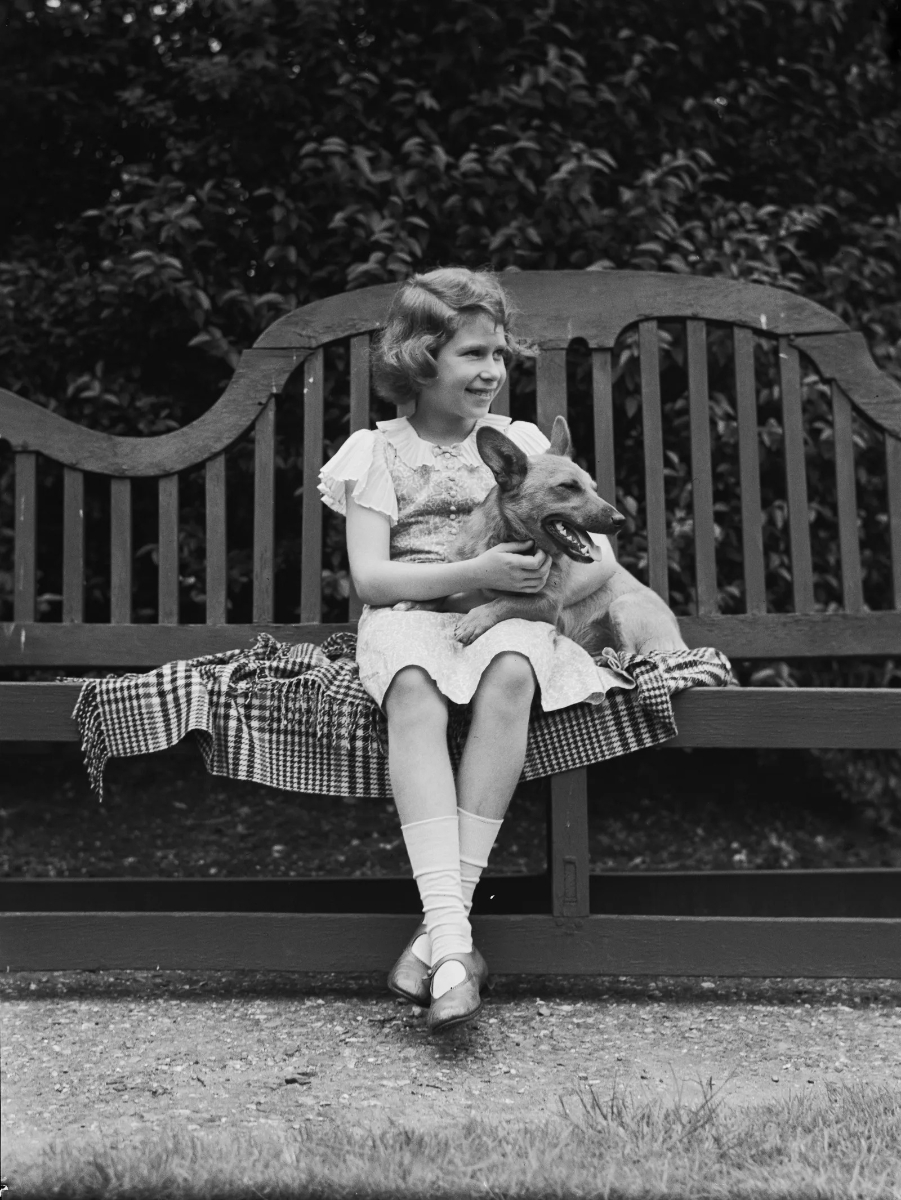
Queen Elizabeth II as a princess with a Pembroke Welsh Corgi in 1936. © Getty Images
Queen Elizabeth II as a princess with a Pembroke Welsh Corgi in 1936. © Getty Images
The photographer Marcus Adams was also the author of a solo portrait published in the May 1st 1928 issue of Vogue in which the infant princess, backlit to accent her aureole of pale curls, dressed in a coral necklace and holding a silver rattle, was included in a portfolio of “Young Persons of Importance.”
By November 1, 1932, the young princess was being saluted by Vogue for having inadvertently made “corn-yellow”—deemed “a highly becoming shade”—an American trend, for the “smart svelte lines of her tailored guardee top-coat” and “shoes are so simple as to be entirely unobtrusive.” The young princesses Elizabeth and Margaret “have set stream-lined, svelte styles for all the Youngest of the Moderns.” These sartorial paradigms would guide Her Majesty through ten decades, transforming her wardrobe from childhood to adulthood, in youth, and in middle and old age into an iconic outward expression of continuity and stability.
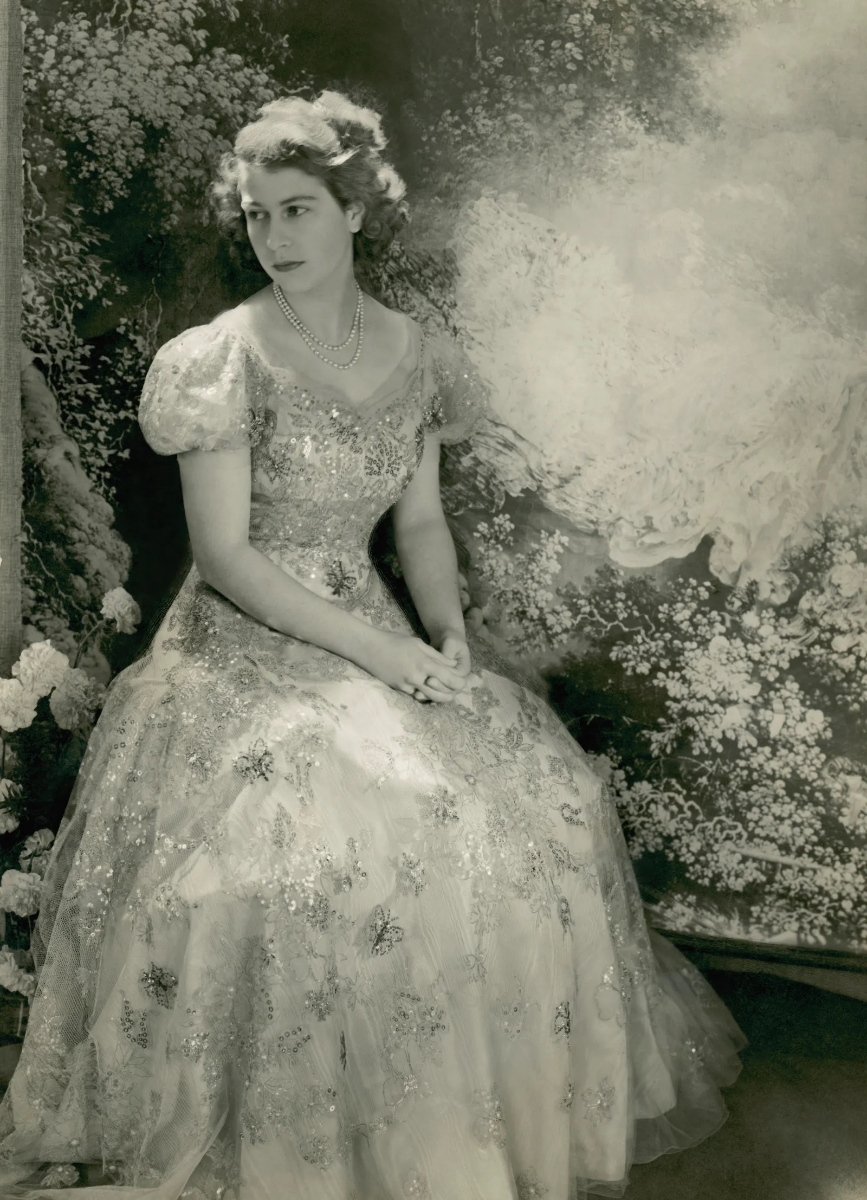
Queen Elizabeth as a princess in 1946, wearing a moire satin dress with a tulle, sequin embroidered overlay. Photographed by Cecil Beaton
Queen Elizabeth as a princess in 1946, wearing a moire satin dress with a tulle, sequin embroidered overlay. Photographed by Cecil Beaton
“Princess Style” was also celebrated in 1937, the year that Princess Elizabeth’s uncle David was due to be anointed King Edward VIII. Princesses Elizabeth and Margaret, Vogue noted, “dress very simply, and very smartly indeed. And they have made children all over the world want to dress as simply and as smartly as they do.” Ronald Pym sketched some of their signature twinning looks, “when the Princesses go to Balmoral in Scotland,” for instance, as Vogue wrote, “they wear real kilts, fringed and fastened with a huge safety-pin, and pull-overs in the brightest color of the plaid used in the kilt.” Meanwhile, their “party frocks are straight out of your favorite picture book with their tight little bodices and full flaring skirts.”
“For 13 years,” Vogue noted, “Princess Elizabeth has been the fashion leader for little girls all over the world. Her baby clothes were noted by every conscientious mama in England … her tiny frocks were copied in thousands of nurseries … The line of her new coat, the tilt of her new hat, have almost as much fashion influence as the Queen’s crinolines or the Duchess of Kent’s hair-dos.”
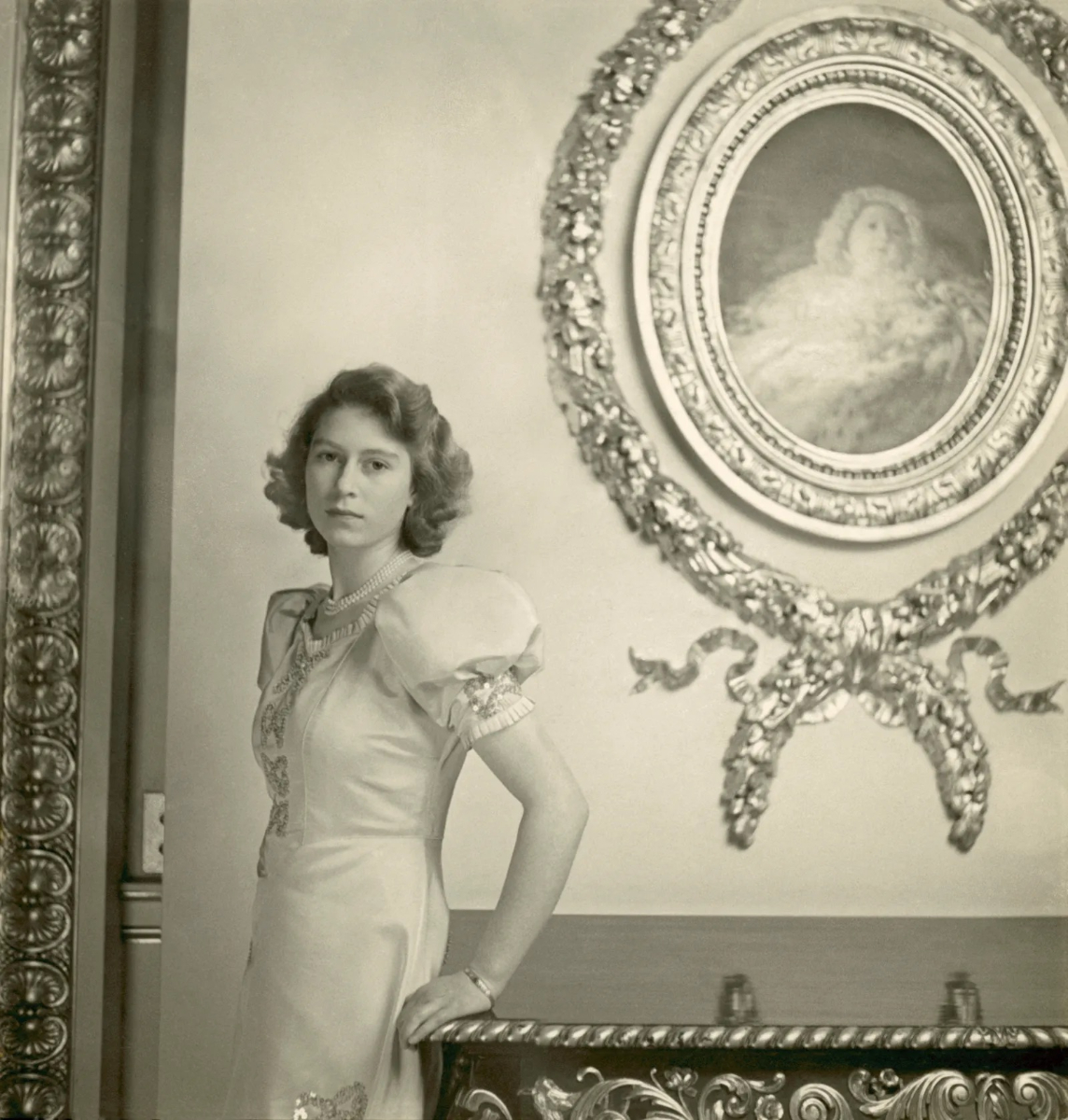
Queen Elizabeth II as a princess in 1947, wearing a dress with puffed shoulders. Photographed by Cecil Beaton
Queen Elizabeth II as a princess in 1947, wearing a dress with puffed shoulders. Photographed by Cecil Beaton
(“In England,” Vogue explained, “sisters are invariably dressed alike until the elder makes her debut,” ergo the elder Elizabeth’s wardrobe was “keyed down to her sister’s classic, conservative clothes.” The young princess was dressed largely in pale colors—pale blue a particular favorite—although she wore yellow sweaters to match her Royal Stuart kilts.
The princess’s uncle David, groomed from infancy to become king and to serve his country, instead succumbed to the brittle jet set glamour embodied in the highly lacquered person of the American double divorcee Wallis Simpson, and renounced his throne in order to be with “the woman I love.” And so his stammering younger brother Bertie suddenly found himself king, crowned at George VI in 1937.
“London’s rank and file plume for the great day,” gushed the magazine’s roving social reporter Johnny McMullin, a friend and confidante of Wallis Simpson. “True, it was to have been another King,” he wrote, somewhat wistfully, “But on a night in late December, driving all alone by the side of his chauffeur in a big blue car, King Edward went down to Portsmouth and sailed away in the night—doing, as someone said, “the wrong thing in the right way”—and that chapter was closed, English fashion.”
“The actors are different,” he continued, “but the play is the same.”
“These people are,” one hears, “so suitable.” McMullin added, “Will ‘these people’ entertain? Whom will they see? And what will this new Court be like? Naturally, society is intensely interested.”
“When George V died, and Mrs. Simpson came over the horizon,” the novelist Rebecca West wrote in Vogue forty years later, “it must have seemed to Queen Mary that she herself had failed morally. If she had made Buckingham Palace a happy home for her husband, it had not been quite that for her children.”
“They were not popular and they knew it,” Rebecca West noted bluntly of the Queen’s parents, “The Duchess of York was not of royal blood, and they had never acquired any great social authority. Simple and shy people, they were content with their private life…The Yorks consented to be King and Queen out of a sense of duty.”
“Without sentimentality,” West conceded of George VI, “one can call him a sweet man. He was not at home in this wicked world but he bore himself gallantly. The effort made him stammer but his expression was eloquent.”
The Queen’s parents may not have possessed the shiny, hollow glamour of the Windsors but these were not qualities that had distinguished King George V and Queen Mary either. Instead, having borne witness to the destructive qualities of chic and glamour, the new royal family made a virtue of their ordinariness, presenting themselves as a close-knit nuclear family leading lives of cozy domesticity that many middle-class Britons could identify with. When the nation wanted Cinderella romance, pomp, and ceremony, however, they could provide that too.
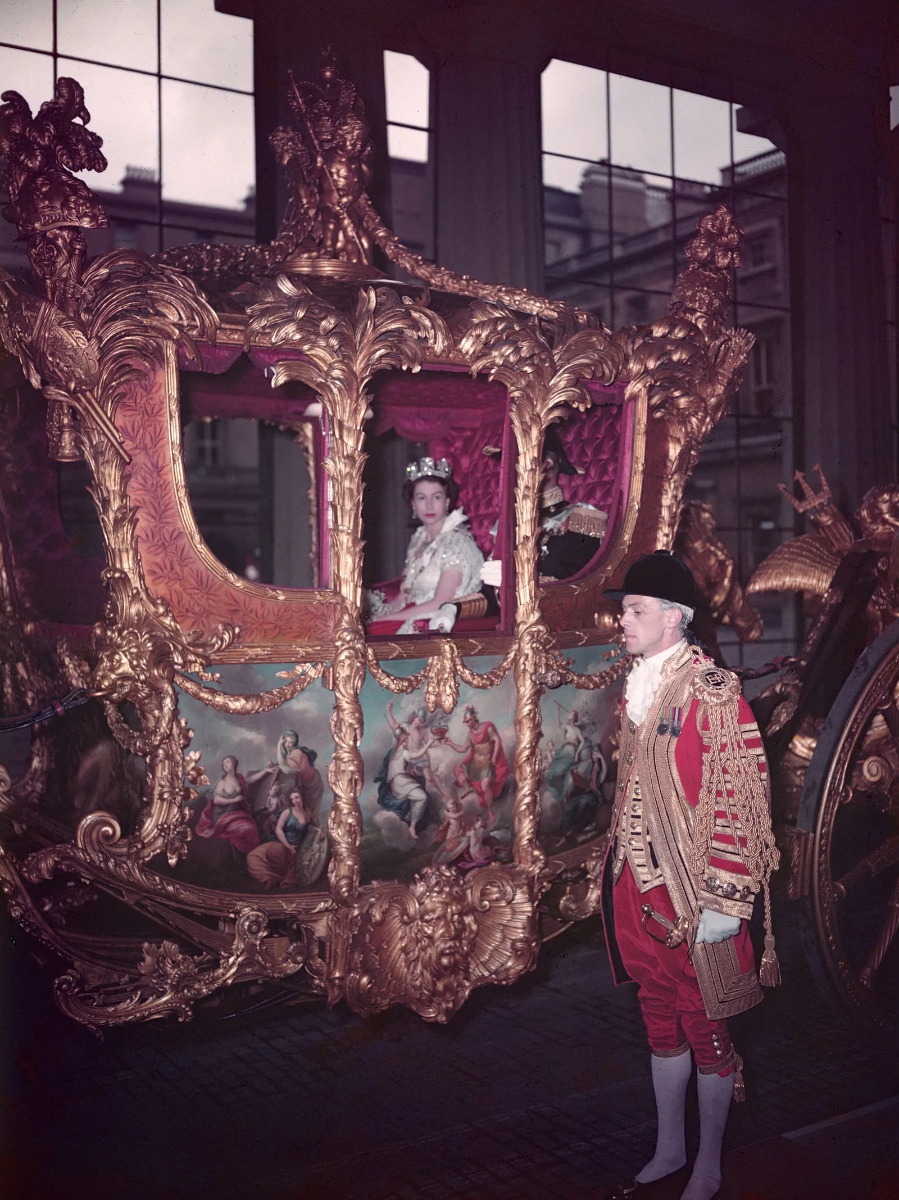
Queen Elizabeth II in the coronation coach on her way to be crowned at Westminster Abbey in 1953. © Getty Images
Queen Elizabeth II in the coronation coach on her way to be crowned at Westminster Abbey in 1953. © Getty Images
Vogue reported on the details of this coronation in fascinating detail: the peers were allocated nineteen inches of seating space, commoners a mere eighteen; and as the seven thousand Abbey guests could not “go back and forth to the gentlemen’s or ladies’ rooms,” the guests, “like the guardsmen who line the route, all must eat dry from six o’clock the evening before.”
In the year of her parents’ coronation, Vogue hailed Princess Elizabeth as “the world's most important child, [who] shares the British Public's affections with Shirley Temple … She sees selections from her fan-mail, has no nerves at all, has to apologize for too-witty replies, is not being overeducated, but has been told what she is in for....”
At 13, the princess was deemed “very self-possessed.” She had now graduated from coral beads to a diamond bracelet that her father King George VI had gifted her for this significant birthday: her mother gave her her first long silk stockings. “She has her own sitting room at Buckingham Palace,” noted Vogue, “ orders her own flowers, arranges menus and issues invitations for her own parties, and is patroness of a charity.”
By the time Vogue published its February 15, 1943, issue, however, this decorous life was over: Britain was at war, and when the 16-year-old H.R.H. Princess Elizabeth appeared in Vogue, posing for Cecil Beaton, she now wore a martial hat and the diamond-set badge of the Grenadier Guards of which she was the Honorary Colonel (“the first woman in history to command a senior regiment of foot guards”), pinned to the label of her tweed suit.
She was, noted Vogue approvingly, “competent with a six-bore shotgun,” and at a benefit show at Windsor Castle, “she sang duets, tap danced, gave a piano solo, and led community singing.”
The young princess was evidently being groomed for the rigors of a life of service. “A zealous Girl Guide she has learned First Aid and Home Nursing certificates, and is now specializing in Sea Ranger training,” noted Vogue, “She lends an elbow to a palace stirrup-pump team, meets diplomats with her parents, inspects aerodromes, makes radio broadcasts to the children of the Empire. Kept to an unbudging routine of studies that include reading history with the Vice-Provost of Eton, she’s a pretty girl undergoing a procession of education plain as porridge.”
o celebrate the princess’s coming of age, Vogue published a watercolor portrait by Princess Marina of Kent, the chic widow of Princess Elizabeth’s uncle Prince George the Duke of Kent, who had been killed in a military air crash the year before.
Happily, Cecil Beaton was back for a photographic portrait published after the war on March 1, 1946. This time, “The Heiress Presumptive to Britain’s throne and the handsome symbol of Britain’s continuity” now 19, and “soon to visit America and the Dominions,” was shot against one of Beaton’s famous backdrops, blown up from the detail of a Fragonard painting, wearing a dress of tulle fluttering with sequined butterfly embroidery created by Norman Hartnell. Hartnell had first dressed the young princess in a pneumatic dress of tulle ruffles as the bridesmaid to her uncle the Duke of Gloucester when he married Lady Alice Douglas Scott in 1935.
At the time, the princess’s mother, then the Duchess of York, had been so taken with how pretty the dresses that Hartnell had created for her daughters were that she invited him to submit some designs for her, and delighted with them, she moved her entire patronage to him (Queen Mary also ordered some dresses from him, but when the bill arrived, she returned it: apparently she considered that he had undersold himself and insisted on paying him a guinea more for each dress).
The lavishly embellished, Winterhalter-inspired evening looks and fluttering pastel day-time confections that Hartnell designed for Princess Elizabeth’s mother would come to define her soft, romantically afashionable image for the rest of her life, as Queen and subsequent Queen Mother. Hartnell and his preeminent client scored a particularly memorable fashion coup on George VI and Queen Elizabeth’s State Visit to France in July, 1938. The Queen’s mother, the Countess of Strathmore, died unexpectedly that June, and the elaborate wardrobe that Hartnell had devised, in a variety of pastel tones, was deemed inappropriate in the circumstances. Instead of remaking the collection in mourning black, however, the theatrically minded Hartnell discovered a precedent for white as a symbol of royal mourning and so the entire wardrobe was recreated in that shade that proved luminous in print and on newsreel, making the diminutive figure instantly recognizable in a crowd, influenced the Paris haute couture designers, and set the style that the queen would follow for the rest of her long life (she died on 30th March 2002, aged 101).
But Norman Hartnell’s greatest royal fashion coups (and a knighthood) were still to come.
In 1938, the dashing, flaxen-haired Philip Philip of Greece and Denmark entered the Britannia Royal Naval College at Dartmouth, where he won the King’s Dirk as the best cadet of the year. (As a midshipman on various cruisers and battleships, he was mentioned in dispatches and subsequently named second in command on the destroyer Wallace.) It was at Dartmouth where he first met the young Princess Elizabeth, then 13, and her sister Princess Margaret when they came to visit. The former was struck by the young man whom Vogue’s writer, Ray Livingstone Murphy (a biographer of Lord Mountbatten), considered “tall, blonde, with the shoulders of an athlete, a firm chin, and frank eyes.” The young princess and the fashion lieutenant began to correspond with one another, she kept his photograph on her desk, and romance eventually bloomed.
The couple wed on November 20, 1947. “The Wedding became a pageant to refresh the inner eye,” noted Vogue in the January 1948 issue, “to expand the historical imagination. At its center were two young people, surrounded by the full resources of the church and royal state—gold plate on the high altar, trumpeters, glass coaches, tiaras, Household Cavalry, mediaeval standards.” British Vogue surrendered their assigned press seat to the Polish-born expressionist painter Feliks Topolski, who had lately distinguished himself as an official war artist, and American Vogue shared his wonderfully evocative lightning sketches of the scene—capturing, in his impressionist brushstrokes, such recognizable figures as the dowager Queen Mary in one of her distinctive toque hats.
The Princess was dressed by Hartnell in a gown of British woven silk satin, inspired, as the designer noted, by Boticelli’s Primavera and embroidered with seed pearls in foliate designs. The bloom-shaped pieces cut from the dress to form the design were re-embroidered onto the veil and the effect was suitably romantic and theatrical for a nation starved of glamour through the make do and mend war years and the rationing and austerity to follow. (Although already glamorous Princess Margaret had already embraced the soft-shouldered romance of Christian Dior’s New Look—and would soon dress a tad unpatriotically with the designer himself—her elder sister still followed the hard-shouldered wartime line).
“Everybody knows,” wrote the historian A. L. Rowse in Vogue, “that the marriage of Elizabeth and Philip was a love match like that of Queen Victoria and the Prince Consort.” (Queen Victoria’s consort, Prince Albert of Saxe-Coburg and Gotha, capitalized on his outsider status to transform British taste, leaving a permanent mark on his adopted country’s cultural landscape. He was the driving force, for instance, behind such initiatives as the Great Exhibition of 1851, and gave his attention and name to the future Victoria & Albert Museum and the Royal Albert Hall. Prince Philip’s artistic tastes were more representative of the middlebrow tastes of his adopted country, although he was no philistine. In 1958, for instance, he commissioned the Jubilate Deo from composer Benjamin Britten, and asked Topolski to create what would prove to be a wonderfully evocative, 100-foot-long mural of the Coronation celebrations, that now greets ticketed visitors to Buckingham Palace).
For Prince Philip, however, his role was clear: to support his wife and stabilize the crown. “He told me the first day he offered me my job,” Michael Parker, the prince’s first private secretary, related to his feisty biographer Fiammetta Rocco, “that his job—first, second, and last—was never to let her down.”
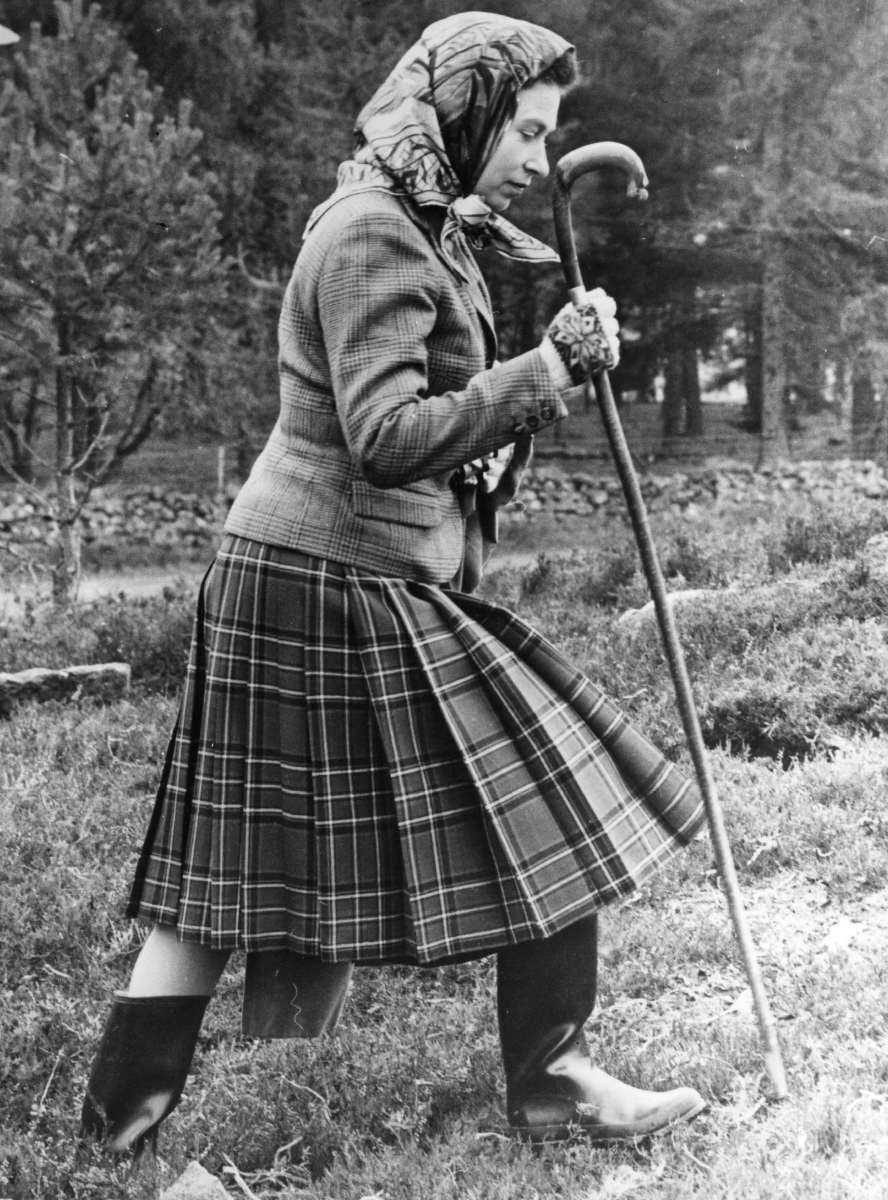
Queen Elizabeth II on the grounds of Balmoral Castle in 1967. © Getty Images
Queen Elizabeth II on the grounds of Balmoral Castle in 1967. © Getty Images
Six years after the wedding, in the middle of a royal tour of Africa, India, and Australia, this role became preeminent when the princess’s father, the self-effacing King George VI, died at the age of 56 of coronary thrombosis (he had been a heavy smoker throughout his adult life) and his eldest daughter ascended to the throne. For Prince Philip, who had finally discovered the stability of family life and was enjoying the home that the young couple had created together at Clarence House, it must have been another profound upheaval in a young life already defined by them. He also had to give up his beloved naval career, a loss that he can only have felt keenly. Instead, he dedicated himself to public service: over the ensuing decades he became the diligent patron, president, or member of more than 780 organizations, and by the time he retired from official duties in 2017 at the age of 96, he had completed a giddying 22,219 solo engagements—and, of course, many more with his wife.
“The catching excitement in this Coronation of a young Queen,” wrote Vogue in 1953, “ goes far beyond the people of her own Dominions, for she holds the affection and admiration of a world which watched her grow up. Her Coronation stands for the security of continuity: this ceremony in Westminster Abbey on June the second is the oldest ceremony of its kind in the Western world, held on substantially the same spot, in practically the same words for almost nine hundred years… To this ritual, the Queen, the thirty-eighth sovereign thus crowned, brings not only her youth, her devotion, and her acceptance of the beauty in tradition, but the promise to live what she is crowned: Elizabeth the Second, by the Grace of God of the United Kingdom of Great Britain and Northern Ireland and her other Realms and Territories Queen, Head of the Commonwealth, Defender of the Faith.”
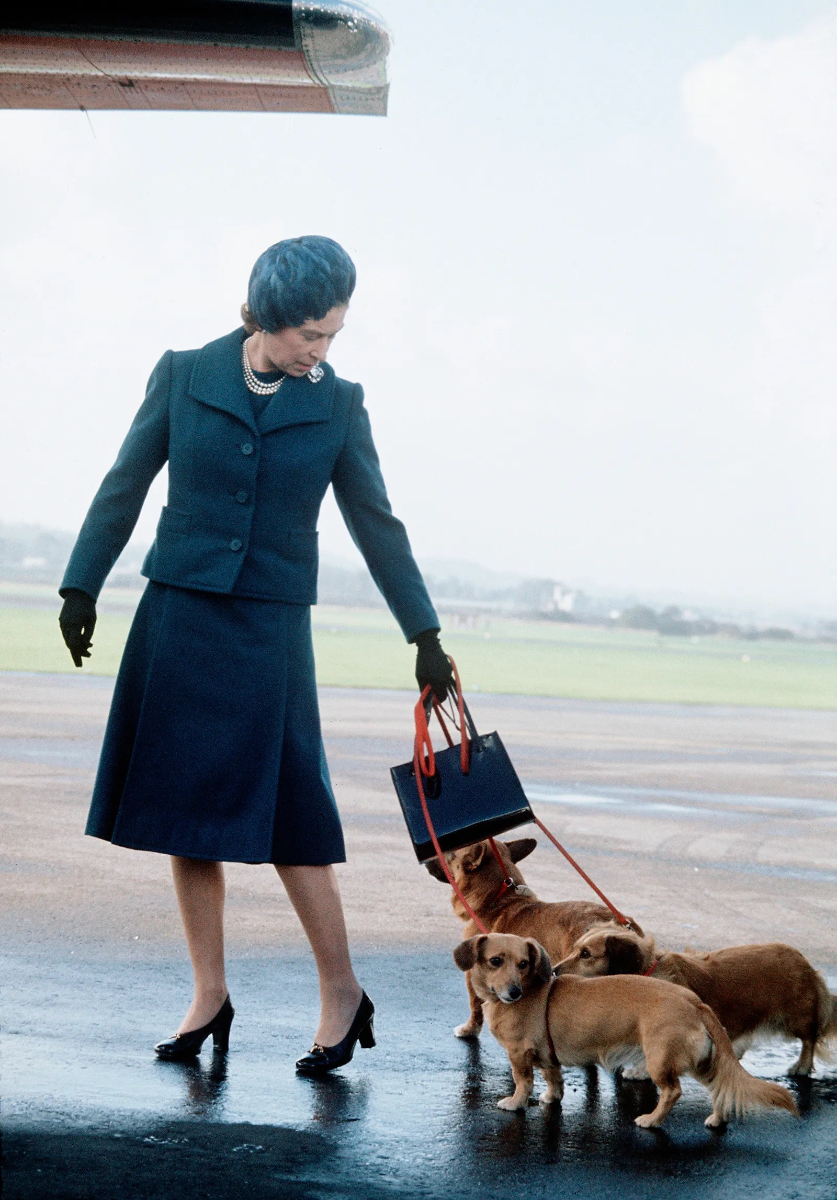
Queen Elizabeth ll arrives at Aberdeen Airport with her corgis in 1974. © Getty Images
Queen Elizabeth ll arrives at Aberdeen Airport with her corgis in 1974. © Getty Images
“What has to be the extent of her dedication only she knows” asked Elizabeth Bowen in Vogue’s coronation year issue, “How dare we compute the weight of the crown?” Few can have anticipated the extent, power, and longevity of that dedication.
Hartnell, too, rose to the occasion which a magnificent coronation robe of stiff white satin embroidered in silken thread and spangles with the symbols of the four countries that compose the United Kingdom—the rose of England, the thistle of Scotland, the shamrock of Northern Ireland, and the leek of Wales (Hartnell lobbied unsuccessfully to have the latter substituted for a daffodil but his fabled embroiderers did a beautiful job with mauve and soft green shaded thread work). The dress represented the spirit of monarchy translated into cloth.
Through the decades, Hartnell, Sir Hardy Amies, Sir Ian Thomas, Stuart Parvin, and latterly Angela Kelly have dressed the queen in daytime ensembles of striking and uniform color, hat to garment, so that she would stand out in a crowd, and in evening dresses designed to set off royal orders and jewels, and in many instances pay subtle homage to host nations (wattle flower embroideries for Australia, maple leaves for Canada, green and white in Pakistan like the colors of that country’s flag, California poppies for a visit to the Reagans).
In 1957, Vogue thrilled to the news of the visit of HM Queen Elizabeth and Prince Philip to America that October. “Their presence on these shores … will be felt in a widening ripple of excitement, enchantment. Their visit gives the autumn of this year a special sparkle, a gala air that may outlast the whirlwind trip itself… There is more to this welcoming wave of excitement than pure romanticism: much more than pure curiosity. There is also the solid, ungrudging respect that most of us feel for a young woman, barely out of her twenties, who performs an enormously complicated and taxing job with courage and sensitivity, industry and intelligence.”
In 1963, Vogue reported on the royal couple’s 50-day tour to the Antipodes, giving an inadvertent insight into the demands of such state visits. “In New Zealand,” the magazine observed, the Queen watched sheep shearings, pottery moulding, carpet weaving, and went to the opera in a shining white dress set off by something she had acquired earlier at a yachting regatta: a sunburn.:” “The Australian bush,” noted Her Majesty, “really grips one.”
In 1973, we celebrated HRH Princess Anne’s engagement to Captain Mark Philips, and subsequently the marriage of the Prince of Wales to winsome Lady Diana Spencer. The rest we know. In 2011, Vogue rejoiced at the engagement of Charles and Diana’s eldest son, Prince William, to Catherine Middleton.
In the meantime, to celebrate the Queen’s Silver Jubilee in the May 1977 issue, Vogue ran a portrait by Andy Warhol and commissioned the 84-year-old writer Rebecca West to consider the reign.
“She is,” the feisty West opined of Her Majesty, “one-third a constitutional monarch, one-third a myth, one-third a woman.”
Most popular


Relacionados
.jpg)
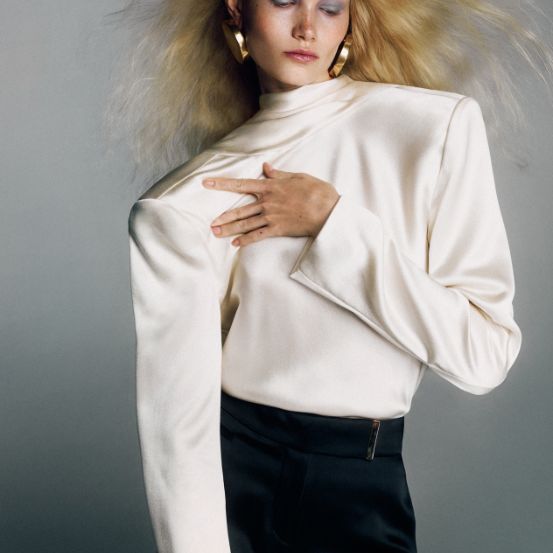

LightHouse Publishing x Street Smash Burgers: uma noite no escritório da Vogue Portugal
19 Dec 2025
 (14).png)


